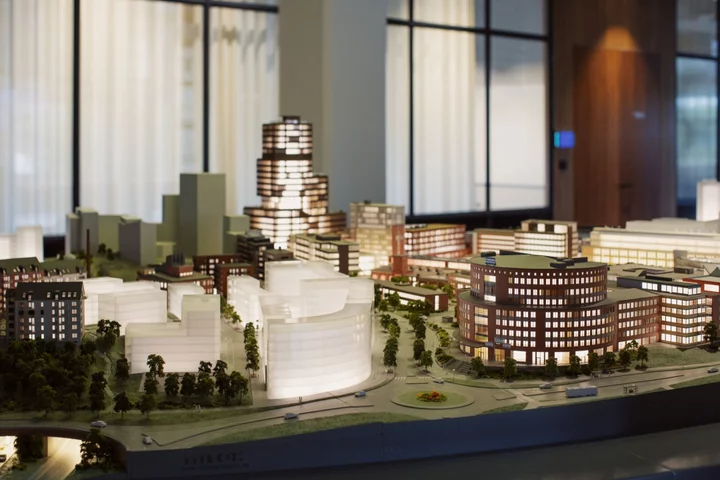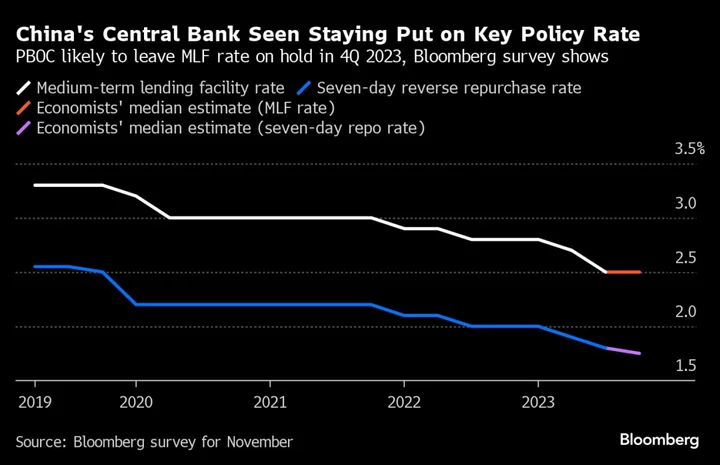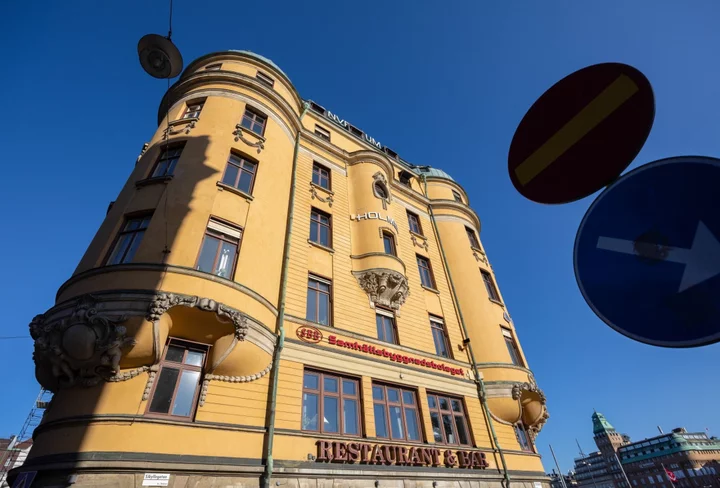This article is part of the Bloomberg Green series Timber Town, which looks at the global rise of timber as a low-carbon building material.
Annica Ånäs, the chief executive officer of Swedish developer Atrium Ljungberg AB, looks out across a parking lot the size of five soccer fields in Sickla, on the southern outskirts of Stockholm.
“All of this will be gone,” she says, gesturing across the cars toward old warehouses with unglamorous shops like dry cleaners and pet-food stores. In its place will rise a new eco-district built out of engineered wood that the developer says will be the largest of its kind in the world, spanning 25 blocks. The neighborhood will include 7,000 office spaces and 2,000 homes as well as shops and restaurants, and will draw on clean energy sources.
Atrium Ljungberg is launching this ambitious project during an exceptionally volatile time in Swedish real estate. Soaring inflation and interest rates have caused havoc in the property market this year, with numerous bankruptcies and falling home values. On top of that are turbulent prices for timber and construction labor and a shifting political climate, as a new Swedish government de-emphasizes environmental concerns.
The plan for a huge development made of mass timber — a class of wood building components fabricated to be extremely strong — could become a global model, ushering in wider use of the material, which proponents and researchers say can significantly shrink cities’ carbon footprints (although that’s a matter of some debate).
But first, it will have to weather headwinds at home.
Read More: What Broke Sweden? Real Estate Bust Exposes Big Divide
“Sure, right now there’s a lot of volatility. But the real estate sector will recover, I’m certain of that,” Ånäs says. “Houses are incredibly important, and there will always be a demand. We will start building in 2025 and the first tenants will move in two years after that, so considering the economic cycles, I think our timing might be perfect.”
She notes that the project will be built in phases and Atrium Ljungberg owns the land, which has lowered its initial costs.
According to Ånäs, what would be riskier in the era of climate change would be trying to sustain the status quo: “In a few years, nobody will be interested in buildings if they haven’t considered sustainability.”
In a country that recently invented a word to shame people over the climate toll of flying (flygskam, which literally means ”flight shame”), the CO2 emissions from construction present an obvious target. Globally the sector is second only to transportation in the harm it does to the environment. Some 37% of global energy-related emissions came from construction and building operations in 2021, according to the United Nations Environment Programme. Cement alone contributes 8% of the world’s carbon emissions, more than three times as much as aviation.
Stockholm Wood City, as it’s known for now, is an example of how Sweden is moving away from emissions-heavy steel and concrete to renewable mass timber. And no wonder. “Sweden is uniquely positioned to benefit from this global shift. Almost the entire country is made up of forest,” says Per Hedberg, founder of Virkesbörsen, a digital marketplace for the Swedish timber industry with 50,000 clients.
In June, building professionals and officials from the US, the UK, Ireland and Japan visited Sweden to see its notable recent wood buildings: White Arkitekter’s Sara Kulturhus in the city of Skellefteå (the country’s first all-wood skyscraper); modular-built apartments in Piteå; and a historic textile factory given a new a timber-framed expansion in Stockholm.
Read More: Subarctic Sweden Is at the Forefront of a $100 Billion Green Tech Boom
The trend is not just for architectural trophy buildings but everyday ones too. Even some supermarket chains are now building mostly in wood, according to Susanne Rudenstam, the head of Sweden’s national agency for modern wood building. Five years ago the agency predicted a doubling of multifamily buildings with a wood core. “Our predictions were accurate. We were at 10% market share then, but we are now approaching 20%,” Rudenstam says.
Rudenstam’s agency — an umbrella organization for wood construction — was founded by the industry with government support in 2005. It’s one example of how Sweden has combined its natural advantages and a long tradition of building wooden houses with concerted efforts to become a global center for modern timber construction.
The government has updated regulations to allow for taller wood buildings. (For many years, they could be no higher than two stories.) Another variable: “There’s also a critical mass of talent throughout the entire supply chain, from the timber industry, to architects, developers and urban planners,” says Carina Carlman, head of research and business development at RISE, a government research institute working with Atrium Ljungberg on Stockholm Wood City.
Landowners and timber companies have also become more attuned to environmental concerns, says Hedberg, partly due to extreme weather events such as 2005’s Cyclone Gudrun, which destroyed more timber in Sweden than is usually logged on an annual basis. “Many of [our clients] would rather see their timber used for sustainable buildings than to see it used only for toilet paper,” he says.
As “plyscrapers” rise from Vienna to Sydney and Seattle to Tokyo, Sweden has increased its exports of timber for buildings, especially to countries like France and the Netherlands, where government agencies now require the use of wood and bio-materials in public buildings. There’s also rising demand from countries along the Pacific rim, where wood buildings are often preferred as more earthquake-resilient.
But at home, the industry is now contending with the real estate crisis. Soaring interest rates and inflation have been devastating to the property sector and may jeopardize green projects across the country. High interest rates have led to a drop in house prices, which has already led to a slowdown in homebuilding.
”There is a risk that this crisis delays the green shift in construction in Sweden. There’s also a risk of brain drain, as developers postpone large projects, and architects and highly skilled professionals start looking for work elsewhere,” says Rudenstam.
Lumber prices have also been volatile, with post-pandemic inflation escalating after Russia’s invasion of Ukraine, which led to sanctions on wood imports from Russia and Belarus. Hedberg predicts a gradual increase in prices over the next few years.
Robert Boije, chief economist at SBAB Bank, says demand for new construction at the moment is “extremely low” and that projects “have been hit by the rise in prices on materials, but we have also seen prices on existing homes fall at least 13%, which makes it harder to price new construction competitively.” He adds, “I expect 2024 to be a lost year for the industry.”
Read More: Sweden’s Debt-Laden Landlords Veer Closer to Forced Sales
Some green building plans may be canceled amid a rise in corporate bankruptcies, driven primarily by failing construction companies and struggling developers. With few of its properties in debt, however, Atrium Ljungberg has seen its stock perform well even as competitors collapsed.
Ånäs predicts there will be demand for sustainable office space near public transit — Stockholm Wood City will have access to a newly built station as Stockholm expands its subway system — by the time the project starts to open. “Where will companies want to sit in the future? They will ask for buildings that are sustainable, energy efficient and where employees are happy, and wood can deliver on all of that,” she says.
Boije is pessimistic about new construction in the short term, whether it’s timber or any other material, but he’s more optimistic about the time frame for Stockholm Wood City. “A project launching four years from now might be better off,” he says, due in part to EU directives to make the bloc’s buildings more energy efficient and sustainable, which should favor wood construction.
Transit access will be a draw, he adds. “Fewer people want to sit in their cars for long commutes. But there is a potential for sustainable office buildings where commutes are shorter, especially with access to good public transit.”
Sweden’s new conservative government has been criticized by environmentalists for reducing fuel taxes, ending subsidies for new electric vehicles and cutting the amount of biofuel mixed into petrol and diesel. But Ånäs says the country’s real estate sector has already reached a consensus on prioritizing sustainability. “This is actually an area where business leaders are already a step ahead of policymakers. The developers are so committed to sustainability that I can’t see how that could turn around,” she says.
“If we don’t make this transition, we would eventually lose investors,” she says. “A nd eventually, we wouldn’t be able to find employees, either.”









